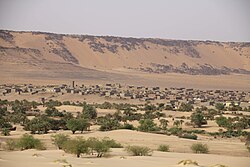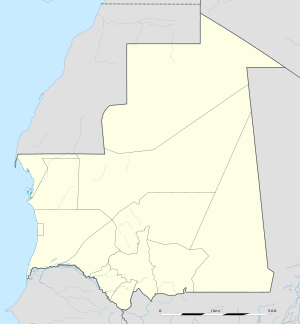| Tichit | |
|---|---|
| Commune and village | |
 Tichit, with Dhar Tichitt escarpment in the background Tichit, with Dhar Tichitt escarpment in the background | |
 | |
| Coordinates: 18°26′30″N 9°29′30″W / 18.44167°N 9.49167°W / 18.44167; -9.49167 | |
| Country | |
| Region | Tagant |
| UNESCO World Heritage Site | |
| Official name | Ancient Ksour of Ouadane, Chinguetti, Tichitt and Oualata |
| Type | Cultural |
| Criteria | iii, iv, v |
| Designated | 1996 (20th session) |
| Reference no. | 750 |
| Region | Arab States |
Tichit, or Tichitt (Berber languages: Ticit, Arabic: تيشيت), is a village at the foot of the Tagant Plateau in central southern Mauritania that is known for its vernacular architecture and proximity to the Dhar Tichitt archaeological sites. The main agriculture in Tichit is date farming, and the village is also home to a small museum.
Tichitt Airport has two unpaved runways designated in a barren area 1 kilometre (0.62 mi) southeast of the village.
History
Neolithic
This region includes a long sandstone cliff formation that defines the northern limit of the Hodh depression, near the former lake of Aoukar.
The Neolithic sites of Dhar Tichitt were settled around 2000 BC by agropastoral communities known as the Tichitt culture. Archaeologists including P.J. Munson, Augustin F.C. Holl, and S. Amblard have found some evidence that millet was farmed there from the date of the communities' foundation. The settlements were generally situated on the cliffs and included stone buildings. They are the oldest surviving archaeological settlements in West Africa and the oldest stone-built settlements south of the Sahara. They are thought to have been built by the proto-Soninke people and were possibly the precursor of the Ghana empire. Hundreds of rock art images have been discovered, depicting various animals and hunting scenes. The area was abandoned around 500 BC probably because of the onset of more arid conditions.
Medieval
The town of Tichitt was founded in the 12th century as a caravan stop on the Trans-Saharan trade route linking Oualata to Chinguetti and eventually Sijilmasa. According to legend, seven towns have been built on top of each other at the site.
The Azer dialect of Soninke was spoken in Tichit from the era of the Wagadou Empire until the early 20th century. The name 'Tichit' may be derived from a term meaning 'language of the blacks' in the Tuareg languages.
Modern
The town was self-sufficient and boasted several thousand inhabitants in the early 20th century, but desertification and sand encroachment have led to the abandonment of many structures. In 1996, it was designated a UNESCO World Heritage Site. In 1999, torrential rains caused flooding that damaged 80% of the town.
Vernacular Architecture
-
 The Mosque of Tichitt
The Mosque of Tichitt
-
 A decorated door in Tichit
A decorated door in Tichit
-
 a street in Tichitt
a street in Tichitt
-
 Open space
Open space
-
 A view of the ancient town of Tichit
A view of the ancient town of Tichit
-
 Some modern housing visible in the foreground with many other abandoned historical buildings
Some modern housing visible in the foreground with many other abandoned historical buildings
Climate
| Climate data for Tichit | |||||||||||||
|---|---|---|---|---|---|---|---|---|---|---|---|---|---|
| Month | Jan | Feb | Mar | Apr | May | Jun | Jul | Aug | Sep | Oct | Nov | Dec | Year |
| Mean daily maximum °C (°F) | 29.8 (85.6) |
32.9 (91.2) |
37.5 (99.5) |
40.4 (104.7) |
42.5 (108.5) |
42.0 (107.6) |
38.6 (101.5) |
35.8 (96.4) |
37.5 (99.5) |
38.7 (101.7) |
35.3 (95.5) |
31.6 (88.9) |
36.9 (98.4) |
| Mean daily minimum °C (°F) | 16.2 (61.2) |
19.2 (66.6) |
23.8 (74.8) |
26.9 (80.4) |
29.9 (85.8) |
30.5 (86.9) |
28.2 (82.8) |
26.6 (79.9) |
27.0 (80.6) |
27.0 (80.6) |
22.2 (72.0) |
18.1 (64.6) |
24.6 (76.4) |
| Average precipitation mm (inches) | 0 (0) |
1 (0.0) |
0 (0) |
1 (0.0) |
1 (0.0) |
6 (0.2) |
15 (0.6) |
32 (1.3) |
19 (0.7) |
3 (0.1) |
1 (0.0) |
0 (0) |
79 (2.9) |
| Source 1: http://www.storm247.com/weather/110676228/climate (temperature) | |||||||||||||
| Source 2: http://www.levoyageur.net/weather-city-TICHITT.html (precipitation) | |||||||||||||
References
- ^ Kjeilen, Tore. "TICHIT The living ghost of yesterday's glory". LookLex. Archived from the original on 2020-05-22.
- Holl 2009.
- Munson 1980.
- Fage, J.D (1976), The Cambridge history of Africa, Volume 5, Cambridge: Cambridge University Press, pp. 338, 339, ISBN 978-0-521-21592-3.
- Coquery-Vidrovitch, Catherine (2005), The History of African Cities South of the Sahara, Princeton: Markus Wiener, pp. 42, 43, ISBN 978-1-55876-303-6.
- Holl 2002.
- ^ Ould Ebnou, Moussa (2000). "The Treasures in Mauritania's dunes". The UNESCO Courier. 53 (12): 26–8. Retrieved 13 August 2024.
- McDougall, E. Ann (1985). "The View from Awdaghust: War, Trade and Social Change in the Southwestern Sahara, from the Eighth to the Fifteenth Century". The Journal of African History. 26 (1): 1–31. doi:10.1017/S0021853700023069.
- Michael J Rueck; Niels Christiansen. Northern Songhay languages in Mali and Niger, a sociolinguistic survey. Summer Institute of Linguistics (1999).
Bibliography
- Holl, Augustin F.C. (2002), "Time, space, and image making: rock art from the Dhar Tichitt (Mauritania)" (PDF), African Archaeological Review, 19 (2): 75–118, doi:10.1023/A:1015479826570, hdl:2027.42/43991, JSTOR 25130740, S2CID 54741966.
- Holl, Augustin F.C. (2009), "Coping with uncertainty: Neolithic life in the Dhar Tichitt-Walata, Mauritania, (ca. 4000–2300 BP)", Comptes Rendus Geoscience, 341 (8–9): 703–712, doi:10.1016/j.crte.2009.04.005.
- Munson, Patrick J. (1980), "Archaeology and the prehistoric origins of the Ghana Empire", Journal of African History, 21 (4): 457–466, doi:10.1017/s0021853700018685, JSTOR 182004, S2CID 161981607.
Further reading
- Holl, Augustin (1985). "Subsistence patterns of the Neolithic, Mauritania". African Archaeological Review. 3: 151–162. doi:10.1007/bf01117458. JSTOR 25130453.
- Holl, Augustin F.C. (1998). "Livestock husbandry, pastoralisms, and territoriality: the West African record". Journal of Anthropological Archaeology. 17 (2): 143–165. doi:10.1006/jaar.1998.0321.
- MacDonald, Kevin; Vernet, Robert; Fuller, Dorian; Woodhouse, James (2003). "New light on the Tichitt tradition: A preliminary report on survey and excavation at Dhar Nema" (PDF). Oxford University School of Archaeology Monograph. 57: 73–80.
External links
- Map showing Tichit: Fond Typographique 1:200,000, République Islamique de Mauritanie Sheet NE-29-XV
| World Heritage Sites in Mauritania | ||
|---|---|---|
| Cultural | ||
| Natural | ||